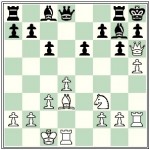In the comments to “The trials of Aibhistín de Búrca” Paul Brown raises the issue of which player played A. Dake at Warsaw (de Burca or Cranston). At IRLchess we have plumped for de Búrca.
De Búrca, in his 1960 article “International Team Tournament Warsaw 1935”, tantalisingly refers to both Dake and the Ireland -v- U.S.A. match; however the two separate passages do not provide an answer.
The victorious U.S.A. team were very even in strength, and consisted of Fine, the brilliant veteran Marshall, Kupchik, Dake and Horowitz. Arthur Dake, playing on fourth board, mowed down the cannon-fodder opposed to him mercilessly and had the best personal score of the tournament (86%).
….
The Irish team was regarded as a push-over by the Americans, who made no secret of their opinion by arriving twenty minutes after the clocks had been started. On three boards, this opinion was speedily justified. This was one of the matches in which I was given my “opportunity”, and played like a terrified rabbit fascinated into immobility by a dangerous snake.
When contemporary sources differ, it can be very difficult to find a definitive solution. However, I believe I’ve found something that goes to the heart of the matter.
In the very first issue of B.H. Wood’s “Chess” magazine, dated 14th September 1935, on page 12 the diagrammed position is given as Exercise No.2. On page 40 of the same issue the following solution is given:
“By Q x Pch, K x Q; P x P double check and mate. Dake v. Cranston at Warsaw.
So far this is just one more contemporary source but in the 14th November issue (at page 83) there was this correction:
“Exercise No.2 in our September number accused Mr Cranston of courting sudden death at the hands of Dake at Warsaw. Actually it was de Burca, reserve for Ireland, who suffered this fate. Our apologies, Mr. Cranston!
All the same, we feel justified in being a little aggrieved ourselves when no less an authority than the Warsaw daily bulletin errs.”
Unfortunately no source is given for the information, but we might guess it was Cranston himself. However it does provide both a 1935 solution as to which Irish player Dake played and an explanation as to how the confusion arose; probably as definitive as it gets. It might be more difficult to determine with certainty whether the game ended with the queen sacrifice or the checkmate.


Thanks for the additional research, David.
The later information in CHESS probably goes a long way towards explaining why so many sources listed Cranston as Dake’s opponent. It’s likely the tournament bulletins were distributed to various media covering the event.
I did find one more source that (erroneously) cites Cranston as Dake’s opponent. The Western Chess Chronicle Vol I No.1 for November 1935 has the game and lists Cranston as Black. It too stops after 18.Qxh7+ (most likely copying the score from the Los Angeles Times, which you cite as one of the sources for the game score).
I will pass on your additional findings to Wojtek over at Olimpbase. I sent him the original research plus the information you initially provided. Your additional research really seems to cement the view that it was de Burca who lost to Dake. It’s unfortunate de Burca did not provide a little more clarity about his opponent in his article.
An amusing aside… in Hans Mueller’s book(let) “Schach Olympiade Warschau 1935”, the names if the Irish players are listed as… Reilly, Creecey, O’Hauston, Cruston, and Burca
David, this post seems to be taking on a life of its own!
Just when I was ready to accept the explanation offered by CHESS (the November issue), another researcher (David Moody) sent me PDF extracts of the Brooklyn Daily Eagle, September 5th, 1935 and New York Times, August 21st, 1935. In the Brooklyn Daily Eagle article, the game is given with Cranston playing Black (and stopping after 18.Qxh7+). More interestingly, the New York Times article actually listed the pairings for the United States vs Ireland. They had it (with USA listed first)… Board 1 Fine 0 Reilly 1 Board 2 Marshall 1 O’Hanlon 0 Board 3 Kupchik 1 Burca 0 Board 4 Dake 1 Cranston 0. The Times also includes the comment that Ireland played White on the odd-numbered boards.
Of course, this is at odds with the BCM round-by-round coverage which had de Burca on 4th board. In examining all the rounds listed in BCM there were multiple instances where one of the Irish players was absent, and in all cases all the other players ‘moved up’ a board with de Burca always playing 4th board. Although the team captain usually has discretion in choosing the substitution order, in all cases it appears the order given in your initial post e.g. Reilly, Creevey, O’Hanlon, Cranston (with de Burca in reserve) was followed in every case, with the respective players ‘moving up’ a board. I see no reason why the team captain would make a change just in round six. This would be especially true if he was trying to field the strongest possible team. This would seem logical given a strong opponent like the USA.
Given that the Brooklyn Daily Eagle and New York Times ‘pre-date’ the correction in CHESS, I’m inclined to believe those two publications were victims (along with Schackvarlden and Ceskoslovensky Sach) of the tournament bulletin error pointed out in the November issue of CHESS.
It’s unfortunate such errors get replicated throughout time. Hopefully, we can put this item to rest with confidence that it was de Burca who played Dake!